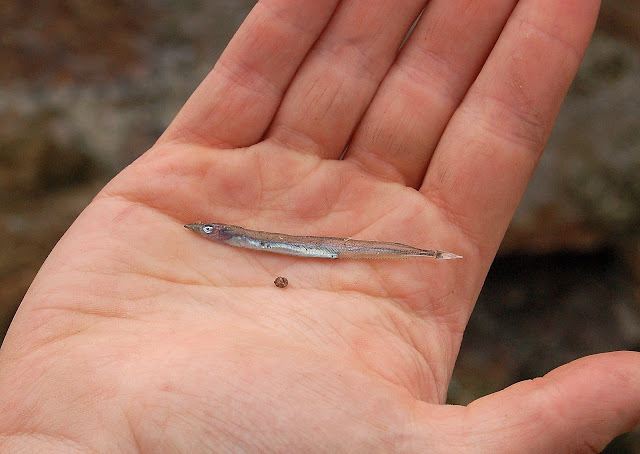Last week we had our own mini-bioblitz on Rockabill! To mark 'International
Biodiversity Day' on May 22nd, the National Biodiversity Data Centre invited
people to spend some time over the weekend recording the wildlife in the
garden, locality or nearest wildlife site, and set a target of 50 species per
individual with the hope of receiving 1,000 records per day. Now it just so
happens our garden, locality and nearest wildlife site are all the same thing
at the moment - the small island of Rockabill, and both being Zoology graduates
we liked the idea of learning a bit more about what biodiversity we share the
island with. And before anyone asks we didn't count birds in our 50 species -
we felt that would be cheating! Or Andrew did at least......
Rockabill, in all of its
uniqueness, has a mix of flora and fauna that you would find on rocky
intertidal seashores, coastal habitats and your average garden or house - don't
forget this was home to the families of the lighthouse keepers for many years,
who grew their own vegetables and planted flowers and hedges out here. Like I
said, unique!
After much hard work we managed
to break the 50 species target! There are definitely species we missed (you'd
be surprised how many different types of seaweed there are...), but here's what
we got....
 |
| You'd be surprised how many plants and animals you can find in even a small rock pool like this - just spend some time, and get a closer look! |
Rock Pool Fauna and Fish
1. Common Limpet
2. Dog Whelk
3. Blue/Common Mussel
4. Beadlet Anemone
5. Acorn Barnacle
6. Common Sea Urchin
7. Common Starfish
8. Common Shore Crab
9. Common Blenny
10. Sandeel
12. Pollock
13. European Sprat
 |
| Common Limpet and Acorn Barnacle |
 |
| Sandeel (a.k.a. Tern food!) |
 |
| Spot the Blenny! (A. Power) |
Seaweeds
14. Bladder Wrack (Fucus vesiculosus)
15. Harpoon Weed (Asparagopsis armata)
16. Kelp (Laminaria digitata)
17. Sea Lettuce (Ulva spp.)
Marine Mammals
18. Harbour Porpoise
19. Grey Seal
20. Common Seal
 |
| Harbour Porpoise (A. Power) |
 |
| Grey Seal |
Plants
21. Tree Mallow
22. Sea Campion
23. Mayweed
24.Scurvy Grass
25. Hottentot Fig
26. Common Dandelion
27. Prickly Sow Thistle
28. Blue Heebee
29. Sea Beet
30. Rock Sea Spurrey
31. Sorrell
 |
| Tree Mallow - it's quite pretty when it's not completely taking over the island..... |
Invertebrates
32. House Spider
33. Garden Spider
34. Woodlouse Spider
35. Garden Snail
36. Common Garden Slug
37. Earthworm
38. Common Centipede
39. Common Woodlouse
40. Common Earwig
41. Ground/Black Click Beetle
42. Fruitfly
43. Bluebottle fly
44. Sandhopper
45. Landhopper
 |
| Garden Tiger Moth larva |
 |
| Common Quaker Moth larva |
 |
| Ichneumon Wasp |
46. Green-veined White
47. Small White
48. Peacock Butterfly
49. Garden Tiger Moth
50. Common Quaker Moth
51. Ichneumon Wasp (Pimpla spp.)
53. Buff-tailed Bumblebee (Bombus terrestris)
Overall we felt it was a great
initiative from the National Biodiversity Data Centre that gave us an excuse to
find out more about what species we share the island with - as well as
highlighting some species groups we need to brush up on...
If we can find 50+ species in a
day on a small, isolated patch of land like this then it should be easy to get
the same amount of species in most gardens up and down the country - so get
outside and get looking! Don't forget to submit your records too, and that it's just as important to record the common species as the more
unusual ones!
No comments:
Post a Comment